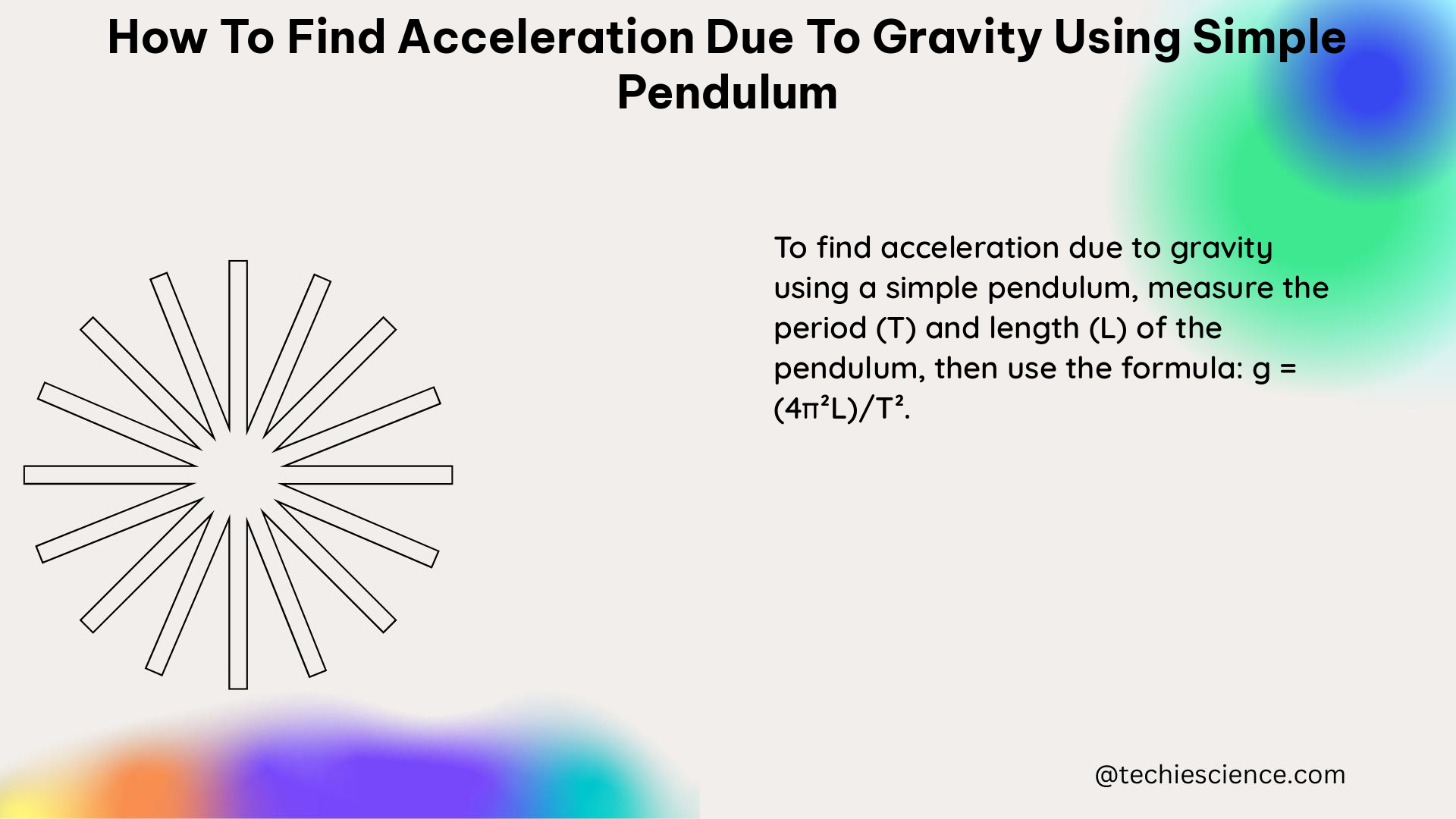Summary
Determining the acceleration due to gravity (g) using a simple pendulum is a fundamental experiment in physics that allows students to understand the relationship between the length of the pendulum, the period of oscillation, and the acceleration due to gravity. This comprehensive guide will walk you through the step-by-step process of conducting the experiment, providing detailed explanations, formulas, and examples to help you accurately measure the acceleration due to gravity.
Understanding the Simple Pendulum

A simple pendulum consists of a mass (the pendulum bob) suspended from a fixed point by a lightweight, inextensible string or rod. When the pendulum is displaced from its equilibrium position and released, it undergoes oscillatory motion, with the period of oscillation (T) depending on the length of the pendulum (L) and the acceleration due to gravity (g).
The relationship between these variables is described by the formula:
T = 2π√(L/g)
where:
– T is the period of oscillation (in seconds)
– L is the length of the pendulum (in meters)
– g is the acceleration due to gravity (in m/s²)
Rearranging this formula, we can solve for the acceleration due to gravity (g):
g = 4π²L/T²
This is the formula you will use to calculate the acceleration due to gravity using the simple pendulum experiment.
Preparing the Experiment
To conduct the experiment, you will need the following materials:
- A pendulum bob (a weight or mass) attached to a lightweight, inextensible string or rod.
- A stopwatch or timer to measure the period of oscillation.
- A ruler or measuring tape to measure the length of the pendulum.
- A stable support structure, such as a clamp or stand, to hold the pendulum.
Step 1: Measure the Length of the Pendulum
Measure the length of the pendulum from the point of suspension (where the string is attached) to the center of the pendulum bob. Record this length (L) in meters.
Step 2: Measure the Period of Oscillation
- Displace the pendulum bob from its equilibrium position by a small angle (typically less than 10 degrees) and release it.
- Use a stopwatch or timer to measure the time it takes for the pendulum to complete 20-30 full oscillations (back and forth).
- Divide the total time by the number of oscillations to calculate the period of oscillation (T) in seconds.
Step 3: Calculate the Acceleration Due to Gravity
Substitute the values of the pendulum length (L) and the period of oscillation (T) into the formula:
g = 4π²L/T²
This will give you the acceleration due to gravity (g) in meters per second squared (m/s²).
Examples and Numerical Problems
Let’s consider a few examples to illustrate the process:
Example 1:
– Pendulum length (L) = 1.2 meters
– Period of oscillation (T) = 2.2 seconds
Substituting the values into the formula:
g = 4π²(1.2) / (2.2)² = 9.81 m/s²
Example 2:
– Pendulum length (L) = 0.5 meters
– Period of oscillation (T) = 1.4 seconds
Substituting the values into the formula:
g = 4π²(0.5) / (1.4)² = 9.80 m/s²
Numerical Problem:
A student conducts a simple pendulum experiment and obtains the following data:
– Pendulum length (L) = 0.8 meters
– Time for 25 oscillations = 35.7 seconds
Calculate the acceleration due to gravity (g).
Solution:
1. Calculate the period of oscillation (T):
T = Total time / Number of oscillations
T = 35.7 seconds / 25 = 1.428 seconds
- Substitute the values into the formula:
g = 4π²(0.8) / (1.428)² = 9.79 m/s²
Factors Affecting the Accuracy of the Experiment
To ensure the accuracy of the experiment, consider the following factors:
-
Pendulum Length Measurement: Accurately measure the length of the pendulum from the point of suspension to the center of the pendulum bob. Any error in this measurement will directly affect the calculated value of g.
-
Period of Oscillation Measurement: Precisely measure the time for a large number of oscillations (e.g., 20-30) to minimize the effect of human error in starting and stopping the stopwatch.
-
Pendulum Displacement Angle: Keep the initial displacement angle small (typically less than 10 degrees) to ensure the pendulum’s motion is simple harmonic.
-
Air Resistance and Friction: Minimize the effects of air resistance and friction by using a lightweight pendulum bob and ensuring the string or rod is lightweight and inextensible.
-
Environmental Factors: Consider factors such as temperature, humidity, and air pressure, as they can slightly affect the value of g.
Conclusion
The simple pendulum experiment is a powerful tool for determining the acceleration due to gravity (g) and understanding the fundamental principles of oscillatory motion. By carefully following the steps outlined in this guide, you can conduct the experiment, collect accurate data, and calculate the value of g with a high degree of precision. This hands-on experience will not only deepen your understanding of physics but also provide you with valuable skills in experimental design, data analysis, and problem-solving.
References:
- The Simple Pendulum – Texas Gateway
- Experiment to measure the acceleration due to gravity g using a simple pendulum – YouTube
- Measuring the Mass of the Earth Using a Simple Pendulum – JEDC

The lambdageeks.com Core SME Team is a group of experienced subject matter experts from diverse scientific and technical fields including Physics, Chemistry, Technology,Electronics & Electrical Engineering, Automotive, Mechanical Engineering. Our team collaborates to create high-quality, well-researched articles on a wide range of science and technology topics for the lambdageeks.com website.
All Our Senior SME are having more than 7 Years of experience in the respective fields . They are either Working Industry Professionals or assocaited With different Universities. Refer Our Authors Page to get to know About our Core SMEs.